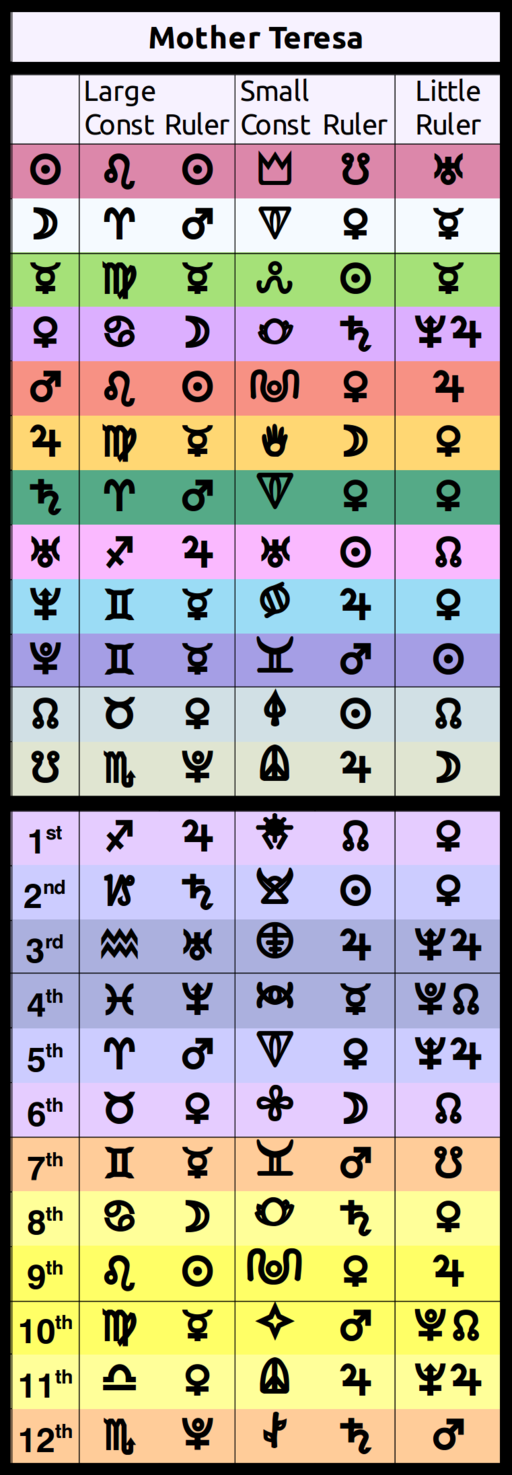

In this case, the rulership of a house in the "native's" horoscope is associated with the planets that rule the sign on the cusp of the house and with any planets found on or near the house cusp. This understanding is followed by most astrologers. Traditionally, however, the rulership of houses was understood to apply only in the individual birth-chart, in what is called "accidental" rulership. Some modern astrologers assign what is called "natural" rulership of each house of the horoscope to a different planet, in the same way as the zodiac signs are said to have rulers. The possibility exists that it isn't involved with any sign, but in any event, it can almost definitely be attributed to the Earth element. For a minority of astrologers, it is the ruling planet of Taurus along with Venus. Significantly, the generation of astrologers who first encountered Ceres in the early 19th century after its discovery, before its demotion to an asteroid in the middle of the 19th century, assigned it rulership of Virgo. For some modern astrologers including many European astrologers, it is the ruling planet of Virgo based upon observation of its role in synastric charts. Although the status of Ceres has not been conclusively decided at the moment in astrology, it has been suggested as the ruler of Virgo or Taurus.


Some astrologers believed that the new co-rulers were primary rulers of the signs with which they were associated and might have been sole rulers of those signs, and if that was the case, two other planets, one linked to Libra or Taurus, and the other to Virgo or Gemini, may await discovery, thus eliminating the need for dual rulership of a sign. The use of dual rulerships in a manner such as this was also be known as "co-rulership". Unfortunately, no allowance was made for these modern suggestions in the complex traditional doctrine of essential dignities, but the idea was very popular. This notion probably had its origin in the concept of astrological sect, but this was the only vestige of the sect in the modern tradition. Similarly, Neptune was the day ruler of Pisces, leaving Jupiter as the night ruler, and Pluto was the day ruler of Scorpio with Mars as the night ruler.

Uranus was designated the day ruler of Aquarius while Saturn was to be its night ruler. Some modern authorities use the concept of "night rulerships" to find room for additional dignities. The discovery of planets outside of the geocentric field of vision in modern times provided a dilemma for astrologers, which most eventually resolved by a consensus declaring Uranus to be Aquarius' ruling planet while assigning Neptune to Pisces and later, Pluto, considered the higher octave of Mars, was given to Scorpio. Since Mercury never appears more than one sign from the sun in either direction, it was deemed to rule the two signs on either side of Leo and Cancer ( Virgo and Gemini), and since Venus can never be found more than two signs from the Sun, it obtained the rulership of Libra and Taurus. Jupiter, being next farthest away, was given the signs on either side of Aquarius and Capricorn ( Pisces and Sagittarius), and Mars, next in order, received the next two ( Aries and Scorpio). The assignments of the ruling planets appear to be based upon the Northern Hemisphere seasons, as the sun (Sol) and the moon, the principal bearers of light and heat, were awarded to Leo and Cancer, respectively, since the months the sun passed through these signs (in ancient times) were the west and had the longest days.Ĭonversely, Saturn, the most distant (and hence the "coldest") of the planets known to ancients, was accorded the rulership of Aquarius and Capricorn, the signs opposite Leo and Cancer, respectively.


 0 kommentar(er)
0 kommentar(er)
